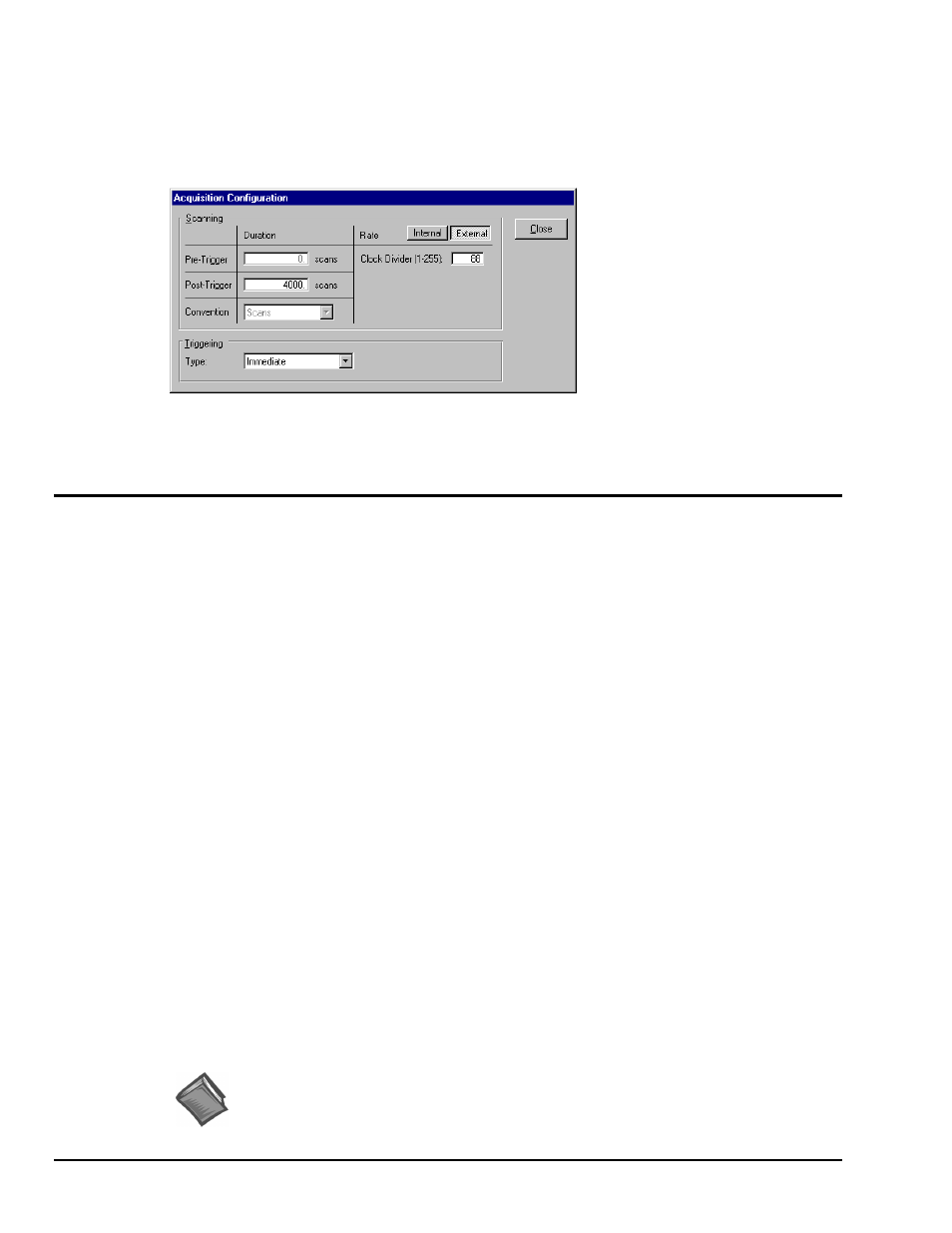External clock input (wavebook/516 only), Trigger operation – Measurement Computing WaveBook rev.3.0 User Manual
Page 144

8-10 Theory of Operation,
6-24-99
WaveBook User’s Manual
External Clock Input (WaveBook/516 Only)
WaveBook/516 can be connected to an external clock through pin 20 of the DB25 Connector. The external
clock is enabled by selecting “External” (for the Scanning Rate) in WaveView’s Acquisition Configuration
Dialog Box. When enabled, WaveBook/516 begins a scan only after a rising edge on the TTL level of the
external clock input occurs. Optionally, the external clock may be divided [by a factor of 1 to 225]. This
“pre-scaling” allows the user to select a reduced scan rate. Note that the Clock Divider default is 1.
Acquisition Configuration Dialog Box, Selecting “External”
WaveBook/516 has an internal counter that calculates and reports the external clock’s period. The counter
can be read with each scan of the analog data. This is often beneficial in later analysis, when correlating
physical phenomena with speed.
Trigger Operation
Triggering is the use of an external signal(s) to start or synchronize the data acquisition process.
WaveBook/512 supports 4 trigger sources, as follows:
• Software Trigger. This trigger event is generated by a software command from the PC without
waiting for an external event. This feature may be used to begin a data acquisition immediately or to
force an acquisition to occur if the expected trigger did not occur.
• Digital Trigger. Digital (or TTL-level) triggering (either rising- or falling-edge input) is performed by
digital logic connected to the digital expansion connector.
• Single-Channel Trigger. Single-Channel (or Channel 1 Analog) triggering (rising or falling signal
level) is performed by comparator-based analog hardware connected directly to analog input
channel 1.
• Multi-Channel Trigger. Here, the trigger event is a combination of measured channel values.
WaveBook's Digital Signal Processor (DSP) performs multi-channel triggering. The DSP samples the
specified channels; if programmable conditions are met, a trigger is generated. Multi-channel
triggering examines digitized data, and the trigger latencies are much greater.
WaveBook/516 supports the four trigger sources identified above, plus two more:
Digital-Pattern Trigger and Pulse Trigger.
• Digital-Pattern Trigger: WaveBook/516 supports a digital-pattern trigger. This expanded
digital-trigger capability allows data collection to start when a user-defined 16-bit digital pattern is
matched on the digital I/O connector. This feature is useful when trying to capture noise, vibrations
or some other physical disturbance; such as those that can occur in a programmed logic controller’s
digitally sequenced process.
• Pulse Trigger: WaveBook/516’s pulse trigger is a high-bandwidth input that enables triggering
and the correlation of lower-speed waveforms with the occurrence of a high-speed pulse. With
pulse trigger, the user defines pulse amplitude between
±5 V and pulse width from 100 ns to 800 ms.
Reference Note:
Software trigger command information can be found in Appendix C, daqX API - Command
Reference under the command daqAdcSoftTrig.
